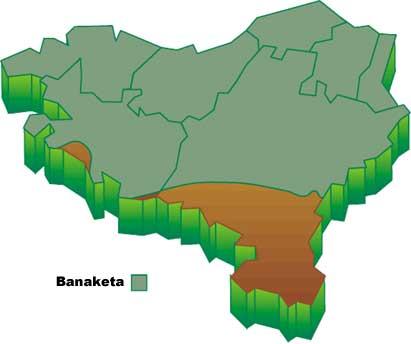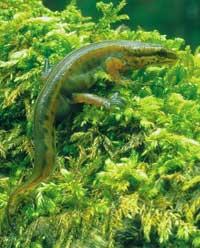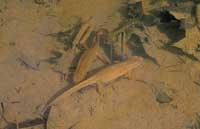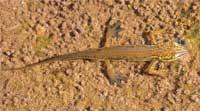PaddTriton, peculiar wedding dancer

As most wild animals normally hide at full speed, it is difficult, if not through books, to know the details of their lives and customs. However, there are exceptions that can be observed calmly. If we start to look at the wells that we almost always avoid, for example, we would find among many other living beings, the tritons. Due to its quiet character and being the most widespread in its surroundings, it is the most easy to find tritons. That's why your amazing wedding dance can be a show for anyone trying it.

The pale triton ( Triturus helveticus) is a slender amphibian of small size. Males have a length of 55-70 mm and females slightly more, about 60-80 mm. The body of these amphibians is dressed in soft brown skin decorated with black scars. The lower part is whitish and in the central and longitudinal part has an orange footprint as ornament.
On both sides of the head you can distinguish the dark footprint that passes through the eyes. The dimorphism between the sexes is evident. In general, the female is somewhat larger than the male and more rounded, with a lighter color. But, undoubtedly, the best time to differentiate the male from the female is the zeal, since the males acquire an unmistakable bridal clothing in this fear: they develop an elegant tuft in the back and especially in the tail and the tip of the tail ends in a black filament of 5-6 mm. On the other hand, the testicles swell completely and develop membranes between the fingers of the back legs forming palmate feet. Hence its name “palmado”.
As in most amphibians, a phase of the life cycle of palmate tritons is mandatory in water, that is, of larval origin, so in reproductive times they live in wetlands. These are therefore areas of ponds, ponds, lakes, waterholes, swamps or streams. Although they may appear in water streams, inert wells like them much more.
It seems that the presence of vegetation or not, or the size of the pond does not condition the presence of these amphibians, as well as small points of water as the watering holes of the sources are suitable for breeding. On the other hand, they can be found both in the plain and in lowlands as in the mountain (between 1,500 and 2,000 meters). Therefore, they also inhabit forests, mountain pastures and many other habitats, provided that there are the necessary humid spaces.
As for the distribution, we can say that it is the western species of Europe, which extends from the Cantabrian region to France, Great Britain, Benelux and Switzerland (Elbe river), which is the origin of the Latin “helveticus”. In the Iberian peninsula we can only find it in the north, in the line that goes from Galicia to Catalonia. The Atlantic wetlands are the ideal place to find the species in Euskal Herria. However, on the Mediterranean side it is also abundant between the south of the Ribera de Estella and the Bardenas. To the south of these dry territories, although it can be found from time to time, it is extremely poor.

Although these urodelos have a strong relationship with water, they become drier outside the reproductive era. However, once on the ground, they must spend the day kept under stones or trunks so as not to dehydrate and can only leave the hiding place at dusk to go hunting. During smoothies they usually capture insects, worms, crustaceans and other small invertebrates. At the end of autumn in the coldest regions are kept between litter and stones to hibernate, but in general, they have an activity of almost all year.
In early spring begins a period of heat that can last until summer. From January or February start to get in touch with the water and then the surprising wedding games begin. The first step is to get to know each other and then the male begins to pay attention to the people around him. When you meet another male they separate immediately, but if it is female, a peculiar wedding dance begins. First, cutting the way to female sleepers. Then the tail leans towards the female area and begins to shake with the tip dancing.
This movement causes a stream of water that sends the couple odorous substances with a biochemical message, suggesting a fertilization signal. However, for fertilization to occur, the spermatoforum of the male (small structure with sperm mass) must reach the sewer of the female, for which they use a curious way of proceeding: once the female has been harvested, the male leaves on foot and, if the couple is willing to reproduce, follows. The male then releases the spermatoforum to the bottom of the water and the couple collects it with the sewers and internalizes it by fertilizing the eggs inside. There is therefore no coplas, but an internal fertilization occurs.

A few days after fertilization, by March or April, the female lays carefully and one by one 200-300 eggs. But to prevent enemies from discovering them, it uses the adhesive cover that eggs have, to leave them well tied to the vegetable seas. When weather conditions allow it takes a couple of weeks or longer to hatch. However, larvae extracted from eggs can easily be separated from the larvae of the anuros (toads and frogs). In fact, the larvae of the tritons are not as large as the tadpoles and have external gills.
On the other hand and unlike the tadpoles, the front legs are first extracted. These larvae are skilful predators that feed heavily on insects, crustaceans, molluscs and other small larvae. When they reach an adequate level of development, they undergo a metamorphosis process and develop the structures necessary for a dry life. After all, they become small 30 mm thick tritons. However, high mortality makes them barely reach metamorphosis and of these, only one of them will become one of those curious wedding dancers.
Species: Triturus helveticus |





